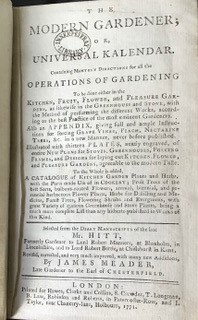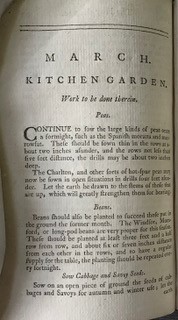Meet The Borrower – 18th and 19th Century ‘Gardners/Gardeners’
As I sit at home looking out across the garden and going through our seed box to see what is leftover from last year, and what we still need to acquire for this gardening year, my thoughts are drawn towards the many ‘Gardners’ who borrowed books from Innerpeffray. Their working lives outdoors would have been governed by the weather and they would have been busy planning and preparing for the months ahead, as well as working under cover in the greenhouses and conservatories. Weather and outdoor ground conditions permitting they would have been preparing the soil ready for sowing and planting, sorting what seeds would be required for the coming year and when to sow them, when to plant out seedlings or new plants purchased for the gardens, and pruning fruit trees and bushes.
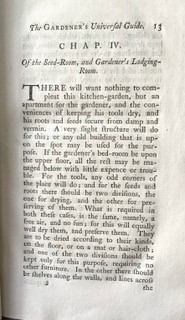
All of the estates around Innerpeffray would have employed a Head Gardener and a varying number of other gardeners to work under his instruction. Most of them would have been provided with accommodation, in what was referred to as the ‘gardeners bothy’. Or there may have been a “Gardener’s Lodging-Room” as noted in “The Modern Eden: or the Gardener’s Universal Guide” by John Rutter and Daniel Carter, published in 1769 (above).
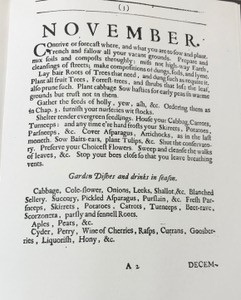
The first ‘Gardner’ mentioned in the Borrowers Register is on the 12th May, 1753, and he was John Allan, Gardner at Innerpeffray. He borrowed “The Saints Highway To Happiness” by Thomas Taylor. His next visit was in February 1854, when he borrowed “Silva, or a discourse on forest-trees and the Propagation of Timber” by John Evelyn, 1706. He borrowed again in April 1764, in March 1766, when his choices were religious texts, and then we don’t see his name again until 28th November, 1776, when he borrows John Reid’s “The Scots Gard’ner”, 1683 (above).
Then on 25th December he borrows “Every Man His Own Gardener” by Thomas Mawe, 1771. There is no further mention of him until July 1807, when he is still recorded as ‘Gardner at Innerpeffray’, Crieff, and he borrows Daniel Hume’s “Essays”. This is the last time we see his name.
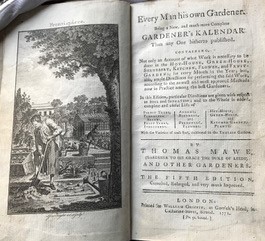
There were two other ‘Gardner’ entries in the 18th Century, each one borrowing on only one occasion. On 18th January, 1755, John Maxton, Gardner, borrowed John Evelyn’s “Silva”, and on 7th July, 1780, James Smith, Gardner, Colquhalzie, also borrowed “Silva” and Mawe’s “Every Man his own Gardener”.
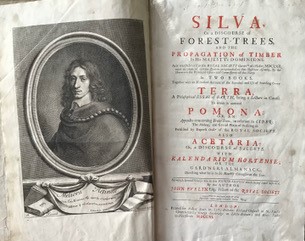
There may have been other gardeners borrowing but no more were recorded as such until 25th July, 1859, when we find John Barnet, Gardner, Inchbrakie. From that year onwards the numbers increase, with some only borrowing once or twice, whilst others visited the library more frequently.
A succession of gardeners came from the Millearn, Abercairney, Dollarie, Colquhalzie and Inchbrakie Estates. Millearn Estate seems almost to have encouraged their staff to come to the library and ‘Duncan Connacker, Gardner, Millearn’, borrows on numerous occasions between December 1859 and January 1861. ‘Fraser McFarlan, Gardner, Millearn’, often comes on the same day as Duncan, and there are other ‘Gardners’ from Millearn – Dugald Taylor, Robert Ferguson, John Drummond and James McInnes – whose names appear occasionally alongside the other two.
Neither Duncan nor Fraser borrowed books on gardening! Duncan obviously enjoyed reading Robert Burns “Life and Works”, which he borrowed three times, and the novels of Sir Walter Scott. He also borrowed The Scots Magazine and his final book, returned on 3rd February, 1861, was “Five years of a hunter’s life in the far interior of South Africa” by Roualeyn Gordon-Cumming, 1850. Robert Ferguson was the only one of these Millearn ‘Gardners’ who borrowed anything relating to his work and the book was “Rudiments of Vegetable Physiology” by William Chambers, 1844.
On the 1861 Census, living in the Gardeners Bothy, Millearn, are Duncan (18), Dugald (23) and Robert (14), all recorded as ‘Journeyman Gard’ner’, and George Anderson (55), ‘Gardner’, his wife and children. Duncan appears to have left Millearn in the 1860s and moved to Rannoch Lodge, where we find him recorded in 1871 as ‘Gamekeeper’. By 1881 he is both ‘Gardener and Gamekeeper’ at Glenalmond House but then continues to move around Perthshire, employed as a mix of ‘Gardener, Coachman and Gamekeeper’.
There were many other ‘gardener’ borrowers in the 19th century, including Donald McOmish, Charles Campbell, John Robertson, George Stewart, George Durward, James Drummond, James McNab and David Smeaton, to name just a few.
However, in this ‘Meet the Borrower’, I want to concentrate on Donald McOmish. Donald was born in 1835, to parents Donald McOmish, a Sawyer by trade, and Elizabeth (McEwan). We first find him on the 1841 Census, living with his mother and siblings John, 9, and Margaret, 8, on High Street, Crieff. There is no trace of him on the 1851 Census, but by then he would have been serving his apprenticeship and may have been missed when information was gathered. Information discovered, suggests that he may have served most of his apprenticeship under Roderick MacDonald at Drummond Castle, and he may also have spent time at Cromlix. His name first appears in the Borrowers Register on 17th November, 1857, and indicates that he was working at Dollarie. Two of the first books he borrowed were about lives of Nelson and the Wellington, indicating an interest in history.
By March 1859, his borrowing record shows that he is at Shearerston, Innerpeffray. On the three occasions he visits the library that year he borrows volumes of “Travels in the East” by Alphonse de Lamartine, 1850. The next entry for him is in March 1861, when he is recorded as “Gardener, Inchbrakie”, and he borrows Philip Miller’s “The Gardeners Dictionary”, 1768.
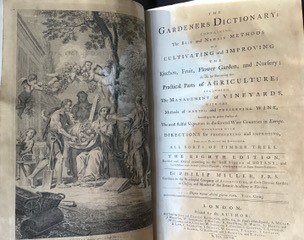
However, by the 1861 Census, taken on 7th April, he is living with his mother at Belview, Crieff, although his occupation is still listed as ‘Gardener’. He borrows again in 1862, “The Wisdome of the Ancients” by Francis Bacon,1681, and Thomas May’s “The history of the Parliament of England”, 1647. Then in February 1863, he borrows “The Scots Gard’ner” by John Reid, and “The Modern Gardener – selected from the Diary Manuscript of the late Thomas Hitt, by James Meade. In November 1863, he borrows the “Plays of William Shakespeare”. This was the last time he borrowed until 1897.
Thomas Hitt, by James Meader, 1771
On the 1st November 1864, in Crieff, Donald married Ann Graham. By 1865 he had established his first Nursery, at Currachreen, Perth Road, Crieff. On the 1871 Census, we see that he and Ann have a daughter, Jessie, 5, and a son, Donald, 3, and are living on Perth Road. Donald is recorded as a “Nursery and Seedsman”. His mother has moved to East High Street, Crieff, and is recorded as an “Outdoor Worker” and so was almost certainly helping her son at his Nursery. After the death of Robert Faikney, Nurseryman at Laiker Farm, Crieff, it would seem that Donald took over the tenancy of that land and may well have purchased the whole stock of “Forest Trees, Ornamental Trees and Shrubs and other plants” which were advertised for sale in the Perth Advertiser “..as one lot by Private Bargain”. The Nursery went from strength to strength and in the December of 1878 he is advertising The Crieff Nurseries in the Strathearn Herald:
“50,000 Larch.
All sorts of Forest, Fruit and Ornamental Trees and Shrubs.”
During his lifetime he specialised in the growing of timber and was responsible for planting Larches at various estates in Upper Strathearn.
By 1881, Donald was working nine and a half acres and employing three men, three women and a boy. The family had grown with the births of John, Malcolm, Elizabeth, Margaret and very new baby, Robert. Another son, George, would be born in 1883, but sadly, daughter Jessie died the same year, aged just seventeen. At one point, Donald’s nurseries covered ninety acres, at Currochreen and Laiker Farm, at Croftnappoch and Milnab. Once his sons left school they all worked with their father as Nurserymen. Son Donald died in September 1897, having been ill for over a year. It is interesting that it was in October 1897, when the family were now living at Croftnappock House, Ramsay Street, Crieff, that Donald senior, after a gap of thirty four years, returned to Innerpeffray to borrow a book.
Another son, Robert, borrowed a book for the first time in November 1897, “Ferns: British and Foreign” by John Smith, 1879, and then visited again in January 1898, when George also borrowed a book on the same day. Robert worked in the nurseries and then he served in the First World War, having first joined for duty in March 1916, when he was 35 years old. He was injured twice, from gun shot wounds, and survived to be discharged from the Royal Artillery in 1919.
Whether he ever returned to live in Crieff we are not sure, but by 1924 he is living in Hertford, England, and is listed in the local trades directory as a fruiterer. Perhaps he had his own small nursery growing fruit, because when he married, aged 47, in 1927, his occupation is recorded as Nurseryman.
Another of Donald’s sons, Malcolm, also a nurseryman, borrowed from Innerpeffray for the first time in March 1898, and the book was “Oceana, Or England and Her Colonies” by James Anthony Froude, 1886. Perhaps reading this book gave him the idea of emigrating to Australia, for that is what he did in the early 1900s. He went to Queensland, where he had a sugar plantation, before moving to Melbourne. He became a Missioner and an Evangelist Open Air Campaigner, often described as a ‘virile speaker’, and his ‘gospel motorcar’ became well known. His son, Donald, retired as the Chief Inspector of the Commonwealth Bank of Australia and was also heavily involved with the Salvation Army. Jokingly, or otherwise, Donald described himself as “… as a hard drinker of whisky – half a bottle of Glenturret a day!” At some point Malcolm was joined in Australia by his sister Margaret, who was living with him in Queensland when he died in 1949. Margaret was staying with her nephew, Donald, in Melbourne, when she died in 1967, aged 90. Donald’s Nurseries had gone from strength to strength, supplying trees and plants all over the country, and further afield, and were visited by many. He died in 1905 and for fifteen years following his death the estate was administered by Trustees. Daughter Elizabeth married Arthur Grimwood in 1907.
On 7th December 1907, D. McOmish, The Nurseries Crieff, were advertising in the Strathearn Herald:
ROSES for all types.
6,000 Roses have been sent from my Nurseries
during the past three weeks to all parts of Great Britain.
Roses were the speciality of son John and plants were exported all over the world. On 17th October 1908, again in the Strathearn Herald:
First Annual
Sale of Nursery Stock
At D. McOmish’s Currachreen Nurseries, Crieff.
Fruit trees, Gooseberry, Shrubs, Hedging, Conifers, Flowering Shrubs, Laurels.
1,000,000 Transplanted Forest Trees – Scots Fir, Larch, Spruce & Douglas Fir
200,000 2yr seedling Larch
100,000 seedling Scots Fir.
At the onset of the First World War, the land use had to be changed to food production and the family uprooted and burnt half a million young trees, for which they could not claim any compensation. In 1920 the business was divided into separate firms under the ownership of two of Donald’s sons, John and George. Both brothers would go on to make a name for themselves in their specialist areas of horticulture.
John, the only one of Donald’s sons who is not recorded as a borrower, became the proprietor of D. McOmish, Currachreen Nurseries, which occupied a site of twenty acres on the Perth Road. The site easily attracted passing customers who stopped to admire the colourful displays and even King George V is supposed to have visited and ordered specimen scented Poplars for Balmoral.
Under John’s ownership the nursery became noted for Roses, Phloxes, Herbaceous Plants and Dahlias. It produced over five thousand Phloxes annually from cuttings, as well as propagating numerous new varieties, such as ‘Gleneagles Glory’ which became popular throughout Europe. It was later grown extensively in the Netherlands. Over the years the Nurseries won numerous awards, nine gold medals and a silver cup for their plants and flowers, as well as the National Sweetpea Society’s supreme award for their display of Sweetpeas.
On the 16th September 1933, John advertised in the Strathearn Herald:
Come and See the
GREAT FLOWER SHOW
Dahlias, Roses etc.
only address
D. McOmish, Currachreen Nursery, Crieff
Currachreen Nurseries continued to advertise throughout the 1940s and into the early 1950s They grew a huge variety of flowering and vegetable plants and were posting these all over the country. Mail Order is nothing new! John died in 1955.
The Croft Nurseries, established by his father in 1869, was taken over by son George and in 1920 became known as George McOmish Ltd.. He also owned a shop on West High Street, Crieff, where the seed department was based. George’s lifelong interest was landscape gardening and he specialised in Alpines. A keen member of the Scottish Alpine Club (for those interested in Alpine flora rather than mountaineering!), plants would regularly arrive at his nursery from France, Switzerland, Bavaria and even the Himalaya. The nursery maintained a stock of over twenty thousand Alpine plants and one of the main attractions was the Rock Garden, where the plants could be grown and displayed in more ‘natural’ surroundings.
In 1934 George was advertising in the Perthshire Advertiser:
Croft Nurseries, Crieff
Rock garden plants.
Alpine, Himalayan, Chinese & all from nearly every country
Dwarf shrubs for rock landscape.
On 26th May 1937 in the Perthshire Advertiser:
Croft Nurseries, Pitenzie Road, Crieff
Seed Dept. 10 West High Street
Largest & most select stock for years.
Another of George’s special collections was that of his Scotch ‘Carnation Pinks’, which he
cultivated to be more suitable for growing in a northern climate. His nursery also grew flowering and ornamental shrubs, more than a hundred varieties of heather and a collection of Hybrid Primulas. Croft Nursery was still advertising
“…alpines and rock garden dwarf shrubs, dwarf
rockery, rhododendrons , azaleas and conifers” and “….weeping cherries, Clematis, Camellias, Magnolias..”
and other choice plants and flowering trees and shrubs, right up until 1972. George died in 1974.
GF

